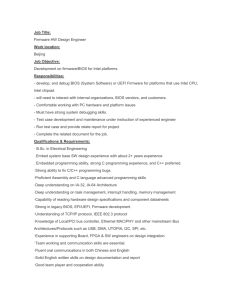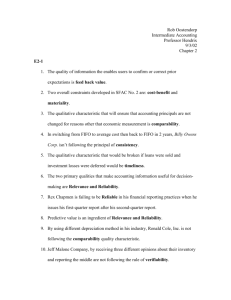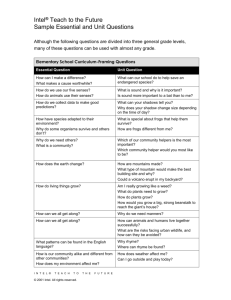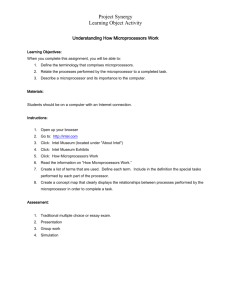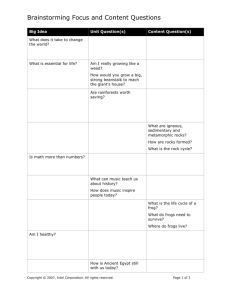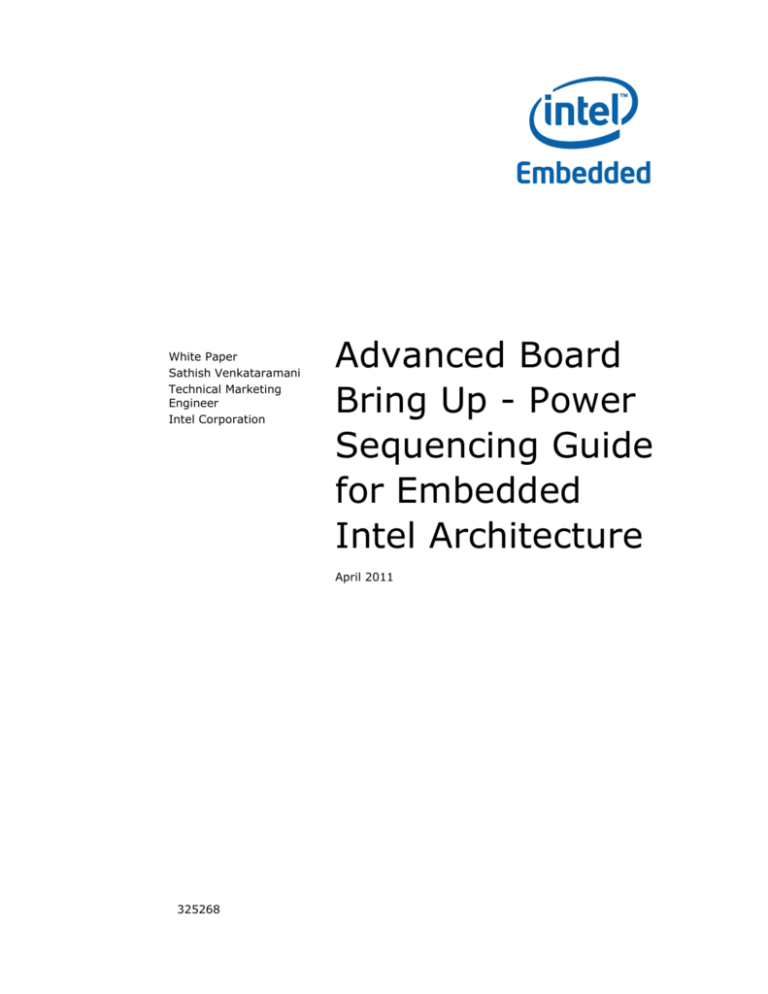
White Paper
Sathish Venkataramani
Technical Marketing
Engineer
Intel Corporation
Advanced Board
Bring Up - Power
Sequencing Guide
for Embedded
Intel Architecture
April 2011
325268
Advanced Board Bring Up – Power Sequencing Guide for Embedded IA
Executive Summary
Board Debug is a critical component in the design path of Embedded IA
boards. The topic is very broad and pertains to a lot of functional areas on
the platform. This paper concentrates in the area of power sequencing
and the debug involved on Embedded IA platforms.
The Intel® Embedded Design Center provides qualified developers with
web-based access to technical resources. Access Intel Confidential design
materials, step-by step guidance, application reference solutions, training,
Intel’s tool loaner program, and connect with an e-help desk and the
embedded community. Design Fast. Design Smart. Get started today.
www.intel.com/embedded/edc.
2
Advanced Board Bring Up – Power Sequencing Guide for Embedded IA
Contents
Tables and Figures ................................................................................................... 3
Introduction ............................................................................................................ 4
Terminology .......................................................................................... 4
Reference ............................................................................................. 5
Before Power on - Tools of the Trade .......................................................................... 6
Power On and Sequencing ......................................................................................... 8
BIOS/EFI .............................................................................................................. 12
Tables and Figures
Figure 1 General Power System Block diagram ...................................................... 8
Table 1 Voltages required by a System with no M3 state ........................................ 9
Figure 2 Platform Power Logic and Signal Block Diagram ...................................... 10
Figure 3 Power Sequence timing Diagram from S4-5/Moff to S0/M0 ....................... 11
Figure 4 A BIOS GUI Screen Shot ...................................................................... 12
3
Advanced Board Bring Up – Power Sequencing Guide for Embedded IA
Introduction
Intel® Architecture designs in embedded systems have been present for a
long time, however the complexity of the systems have grown almost
exponentially with each generation of the IA architecture adding more
hardware features and more devices to the system. This addition of devices
means the power supply into the board needs to be robust to support the
various devices. Apart from the power supply being robust the entire power
subsystem and routing on the board including the sequencing needs to be
spot on so that the board can power up without any issues.
In my previous whitepapers, I have given the basics of what to look for on
the board before you power on the system and also how to check the
accuracy of the layout of the board. There was also a brief introduction to
general power sequencing. The objective of this paper is to take the board
bring up a step further and show the process from actual power on to the
point where you start fetching code from the BIOS. We will have a detailed
look at the Embedded IA board with respect to the signals that make up the
majority of the power up sequencing and how the entire circuitry can be
deciphered easily.
Terminology
Term
4
Description
ICH
I/O Controller Hub
PCH
Platform Controller Hub
IOH
I/O Hub
POST
Power On Self Test
Advanced Board Bring Up – Power Sequencing Guide for Embedded IA
Reference
Reference
Document Number
High Speed Digital Design Principles
321091
Embedded Intel® Architecture Board
Bring Up Procedure
322504
Text editor software
Ultra Edit http://www.ultraedit.com/
Notepad(freeware) http://notepad-plus-plus.org/
Calpella Platform Power Sequencing
Specification
393353
Wikipedia Page for BIOS/EFI
www.wikipedia.com
5
Advanced Board Bring Up – Power Sequencing Guide for Embedded IA
Before Power on - Tools of the Trade
Embedded Intel
®
Architecture boards follow similar guidelines to the mobile
and desktop platforms based on the performance needs of the design. These
guidelines are normally published as embedded collateral at the Embedded
Design Center. If a customer is designing the board to launch along with Intel
they will need NDA access to get the documents through Intel Business Link
or IBL. The main documents needed for a board design are the following.
1. Platform Design Guide
2. Processor Power Delivery Guideline
3. IA System BIOS writers guide for the specific processor
4. Design files of Intel Reference board ( schematics and board files)
One of the greatest tools for a board engineer would be the free PCB/board
file viewer. There are a lot of vendors available such as Cadence, Mentor and
Altium (formerly Protel) that offer good free viewers of the board files of the
design. It is imperative that this tool be available in the lab where board bring
up is planned. It is always good to have a background in soldering wire for
quick fixes or at least have a technician to help out when soldering is
required.
You will also need the following lab tools:
1. Oscilloscope – Very important for tracking signals and also the timing
2. Debug Port 80 cards (For designs that do not have onboard debug
LEDs)
3. ITP (In Circuit Target Probe)
4. Software testing tools (once the board is booting)
There is a lot of material available on oscilloscopes online as well as from the
vendors themselves. Let us look as the second item listed above.
The debug port 80 card has been used in Intel designs for a long time and is
a great tool to have when you are debugging BIOS halts and early bring up
cycles of the processor.
Note: Many newer board designs have this as a part of the board.
The LED panel is present a surface mount part. This device plugs onto the
LPC bus header on the board. The LEDs flash codes during boot up sequence
and the series of codes are various checkpoints during the bios boot up
6
Advanced Board Bring Up – Power Sequencing Guide for Embedded IA
sequence. It is very important to know what the codes stand for as they will
call out in detail the exact point of failure. If a halt should occur at a certain
code, the engineer can then single step through to figure out where the
problem is or try to work around it by completely bypassing that piece of
code untill it gets fixed.
The Intel ITP or Intel in Target Probe is one of the most important tools for a
bios/hardware engineer debugging issues that relate to the processor and
memory. The tool gives access to the various MSRs (model specific registers)
which lets the engineer control very specific features of the processor such as
memory bus speed or error correction. As a customer of Intel products you
have a list of vendors who provide the ITP for testing the platform and
processor.
Finally the software tools are of paramount importance. There is a long list of
software tools that can be used for bring up. The following tools are definitely
high on the priority list before a board bring up.
1. Firmware programmer (BIOS, ME firmware etc)
2. BIOS Debugger utility, essentially a code viewer for debugging the
BIOS on the fly during bring up. Check the reference section for a
couple of common text editors which are used for viewing and editing
code.
7
Advanced Board Bring Up – Power Sequencing Guide for Embedded IA
Power On and Sequencing
This section will focus on the various power rails in the system and how
power sequencing works on an Intel motherboard.
Note: The information in this document is specific to the Intel® CoreTM processor
with the Mobile Intel® 5 Series Chipset platform and may be applicable for
platforms featuring the 2nd Generation Intel® CoreTM processor designs.
Please check the chipset version and specification for the right power
sequencing information.
The following figure shows the main rails in a system coming from the Power
Supply.
Figure 1 General Power System Block diagram
ATX Power Supply
3.3V
5V
12V
5V Stby
We can see from Figure 1 that the main rails into the system are the 12V,
3.3V, 5V and also a 5V Stby. We will discuss more about the three main rails
above, namely the 3.3V, 5V and the 12V. These voltages are used as the
inputs on the various regulators on board. These in turn generate lower
voltages for use on the board. Table 1 below shows a sample diagram of how
many different voltages are required on board for a system without an M3
state.
8
Advanced Board Bring Up – Power Sequencing Guide for Embedded IA
Table 1 Voltages required by a System with no M3 state
From the list above, the amount of voltages that make up the power system
on the board is a considerable number. To ensure that all of the above
voltages are in spec, the engineer is advised to work with the VR (voltage
regulator) vendors.
The entire platform power is controlled by the power sequencing logic, which
is made up of the discreet logic on board as well as the power sequencing
code present on the embedded controller. The control process keeps track of
all the signals starting from the power button push to the platform reset
signal appearing, which signals the start of the processor fetching code.
Figure 2 2 below shows the platform power block diagram used on platforms
based on the Intel® Core i7™ Processor or Intel® Core™ i5 Processor with
Mobile Intel® QM57 Express Chipset.
9
Advanced Board Bring Up – Power Sequencing Guide for Embedded IA
Figure 2 Platform Power Logic and Signal Block Diagram
We can see that the power sequencing is accomplished by the interaction
between the Power logic, the Platform controller Hub (Chipset), and the IMVP
(Processor voltage regulator). For more information on the signals mentioned
in the diagram above please check the Calpella Platform Power Sequence
specification document mentioned in the Reference section.
Furthering this discussion, the Figure 3 shows the power on sequence that
the platform should follow from a system off condition. The figure shows the
major voltages involved and the pattern in which they all should fire in order
to get the system to power on. For more information on the individual “T”
numbers mentioned in the diagram please refer to the Calpella Platform
Power Sequence specification document mentioned in the Reference section.
10
Advanced Board Bring Up – Power Sequencing Guide for Embedded IA
Figure 3 Power Sequence timing Diagram from S4-5/Moff to S0/M0
11
Advanced Board Bring Up – Power Sequencing Guide for Embedded IA
BIOS/EFI
Once the platform reset signal is active and the platform is out of reset, the
processor will start the fetching of the BIOS code. BIOS (Basic Input/Output
System) is a major factor in the boot up of a platform. Most of the Intel
based boards will have BIOS manufactured by an Intel specified BIOS vendor.
A board manufacturer can choose to take any of these BIOS and then work
with the vendor on further tweaking it. Some board manufacturers write and
code their own BIOS for each of their systems with specific features built in to
them, such as support for ECC memory1, support for different speeds of
memory, etc. No matter what the case, the BIOS is a code that needs to be
worked on meticulously or there is a high probability that the system will fail
to run even though all the power and system signals are good.
BIOS needs to load the system and initialize all the devices so that the
operating system can start loading. The secondary function of modern BIOS
is that it provides a GUI in which a user can configure a system and its
devices to operate under different conditions. For example, USB devices can
be made to run only at USB 1.1 speeds for debug purposes or the processor
bus speed can be targeted to either a higher or lower speed based on user
needs. The following figure shows a screen shot of a Phoenix BIOS screen
(source: Wikipedia).
Figure 4 A BIOS GUI Screen Shot
1
12
Supported only on select platforms.
Advanced Board Bring Up – Power Sequencing Guide for Embedded IA
BIOS, however is currently becoming a legacy method of turning systems on.
UEFI or Unified Extensible Firmware Interface is the new method of booting
up a system. The original EFI specification was developed by Intel, and that
defined the software interface between the operating system and the
platform firmware. As stated on the UEFI page of Wikipedia, the newer UEFI
firmware provides several advantages over the previous EFI as well as the
common BIOS such as:
Ability to boot from large disks (over 2TB)
Faster boot-up
CPU-independent architecture
CPU-independent drivers
Flexible pre-OS environment, including networking support
Modular design
For more information on EFI/UEFI please see the reference sections.
The Intel® Embedded Design Center provides qualified developers with webbased access to technical resources. Access Intel Confidential design
materials, step-by step guidance, application reference solutions, training,
Intel’s tool loaner program, and connect with an e-help desk and the
embedded community. Design Fast. Design Smart. Get started today.
http://intel.com/embedded/edc.
13
Advanced Board Bring Up – Power Sequencing Guide for Embedded IA
Authors
Sathish Venkataramani is a Technical Marketing Engineer with
Embedded Communications Group at Intel Corporation.
Acronyms
GUI Graphical User Interface
BIOS Basic Input / Output System
EFI
14
Extensible firmware Interface
Advanced Board Bring Up – Power Sequencing Guide for Embedded IA
INFORMATION IN THIS DOCUMENT IS PROVIDED IN CONNECTION WITH INTEL PRODUCTS. NO
LICENSE, EXPRESS OR IMPLIED, BY ESTOPPEL OR OTHERWISE, TO ANY INTELLECTUAL
PROPERTY RIGHTS IS GRANTED BY THIS DOCUMENT. EXCEPT AS PROVIDED IN INTEL’S TERMS
AND CONDITIONS OF SALE FOR SUCH PRODUCTS, INTEL ASSUMES NO LIABILITY
WHATSOEVER, AND INTEL DISCLAIMS ANY EXPRESS OR IMPLIED WARRANTY, RELATING TO
SALE AND/OR USE OF INTEL PRODUCTS INCLUDING LIABILITY OR WARRANTIES RELATING TO
FITNESS FOR A PARTICULAR PURPOSE, MERCHANTABILITY, OR INFRINGEMENT OF ANY PATENT,
COPYRIGHT OR OTHER INTELLECTUAL PROPERTY RIGHT. UNLESS OTHERWISE AGREED IN
WRITING BY INTEL, THE INTEL PRODUCTS ARE NOT DESIGNED NOR INTENDED FOR ANY
APPLICATION IN WHICH THE FAILURE OF THE INTEL PRODUCT COULD CREATE A SITUATION
WHERE PERSONAL INJURY OR DEATH MAY OCCUR.
Intel may make changes to specifications and product descriptions at any time, without notice.
This paper is for informational purposes only. THIS DOCUMENT IS PROVIDED "AS IS" WITH NO
WARRANTIES WHATSOEVER, INCLUDING ANY WARRANTY OF MERCHANTABILITY,
NONINFRINGEMENT, FITNESS FOR ANY PARTICULAR PURPOSE, OR ANY WARRANTY OTHERWISE
ARISING OUT OF ANY PROPOSAL, SPECIFICATION OR SAMPLE. Intel disclaims all liability, including
liability for infringement of any proprietary rights, relating to use of information in this specification.
No license, express or implied, by estoppel or otherwise, to any intellectual property rights is granted
herein.
BunnyPeople, Celeron, Celeron Inside, Centrino, Centrino Inside, Core Inside, i960, Intel, the Intel
logo, Intel AppUp, Intel Atom, Intel Atom Inside, Intel Core, Intel Inside, the Intel Inside logo, Intel
NetBurst, Intel NetMerge, Intel NetStructure, Intel SingleDriver, Intel SpeedStep, Intel Sponsors of
Tomorrow., the Intel Sponsors of Tomorrow. logo, Intel StrataFlash, Intel Viiv, Intel vPro, Intel
XScale, InTru, the InTru logo, InTru soundmark, Itanium, Itanium Inside, MCS, MMX, Moblin,
Pentium, Pentium Inside, skoool, the skoool logo, Sound Mark, The Journey Inside, vPro Inside,
VTune, Xeon, and Xeon Inside are trademarks of Intel Corporation in the U.S. and other countries.
*Other names and brands may be claimed as the property of others.
Copyright © 2011 Intel Corporation. All rights reserved.
§
15

